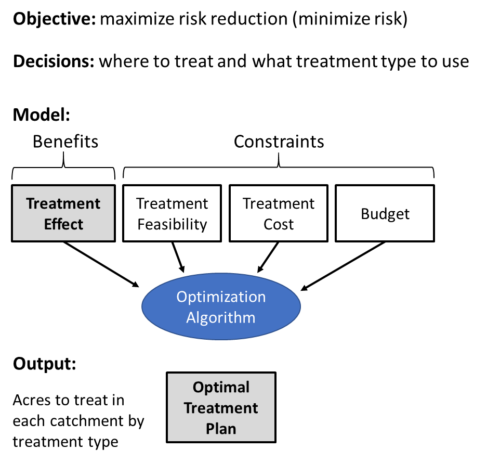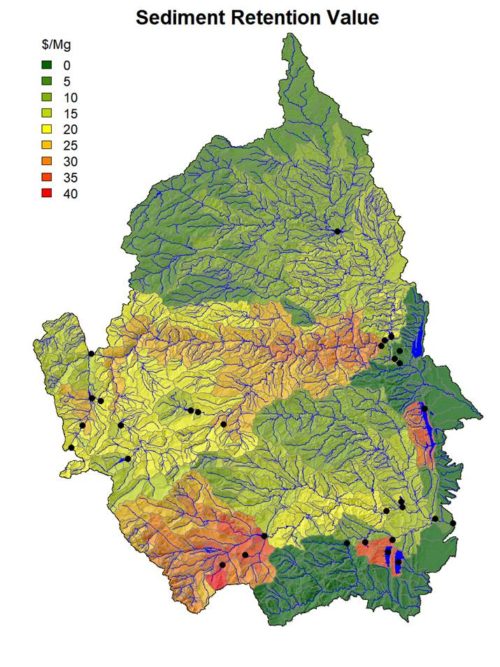Watershed Investment Tool
The Watershed Investment Tool (WIT) is a risk-based assessment and planning tool designed to estimate the benefits of forest fuels reduction and leverage this information to optimize fuel treatment type and location. When we spatially prioritize forest management investments at large landscape scales we can reduce the risk wildfire poses to our water supplies.
The tool analyzes pre-treatment forest fuel conditions, determines the optimal treatment methods (such as prescribed fire and/or mechanical thinning), and helps stakeholders establish project goals. It can also be used to analyze the results of projects to provide measurable outcomes of success and inform future decisions.
While the design of this powerful tool is complicated, understanding the value of its use is easy. Proactively managing the fuels that feed wildfire can reduce post-fire impacts to water supplies. The use of this tool will play a valuable role in the management of our watersheds in Northern Colorado.
Return on Investment is not just for business.
It’s for the prosperity and quality of life we all enjoy – and need to survive.

Try the Tool
Step 1: Determine if you want to view optimal treatment plans based on budget or goal of risk reduction.
Step 2: Select a budget amount or risk reduction percentage to analyze.
Step 3: Select your water provider of interest.
Step 4: See the optimal treatment plan and associated risk reduction based on your selected criteria.
Link: WIT Technical Users Guide
Conditional – anticipated benefit given wildfire burns the treated area.
Expected – anticipated benefit accounting for the probability the treated area is burned by wildfire.
For example, if the predicted sediment avoidance is 100 Mg when the treatment area burns, and the probability the treatment encounters wildfire is 0.1, then the expected sediment avoidance is 10 Mg.

Frequently Asked Questions


Risk is a measure of expected loss for an event that has some uncertainty in occurrence, which is calculated as the product of event likelihood and consequences. The Watershed Investment Tool quantifies risk to water supplies in terms of expected sediment impact costs by combining predictions of post-fire erosion and sediment delivery to water supplies with the probability of burning over a 25 year fuel treatment lifespan. We quantify potential sediment delivery to water supplies with an approach that links fire behavior, erosion, and sediment transport models, and then relate sediment delivery to water supply consequences with stakeholder-defined costs. Wildfire-related impacts to water supplies are associated primarily with high severity fire effects, so fuel treatments that reduce fire severity have the potential to lessen impacts. Risk reduction is estimated by differencing risk for current conditions and after simulated fuel treatments that modify fire behavior (crown fire activity) as a proxy for severity.
Risk reduction varies by treatment type and location on the landscape due to the starting fuel conditions, erosion potential, connectivity to water supplies, and burn probability. The WIT leverages this information to prioritize fuel treatment types and locations to maximize risk reduction using an optimization model that also considers fuel treatment feasibility and cost. The combination of assessment and prioritization capabilities makes the WIT a powerful tool for outcome-based investing.

- We work with local water utilities to prioritize water infrastructure, such as reservoirs and diversions, and value the impact of post-fire sediment and debris.
- We model wildfire likelihood and severity for current fuel conditions and after simulated fuel treatments, such as thinning and prescribed fire.
- We model erosion and sediment transport to water infrastructure for each fuel treatment scenario.
- We quantify wildfire risk as the product of wildfire likelihood and the valued impact of sediment delivered to water infrastructure.
The WIT quantifies fuel treatment risk reduction and optimizes treatment plans for water supplies, but fuels reduction also benefits other human and ecological values. Co-benefits to other resources are estimated using wildfire risk assessment methods that combine burn probability with functions of resource response to predicted fire behavior. This involves mapping resource locations and relating the change in crown fire activity for any overlapping fuel treatments to change in resource risk.
Most resources considered are expected to experience increasing levels of loss along the gradient of surface to active crown fire behavior, so treatments that reduce active crown fire will avoid losses. For structure loss, we used an empirical model that relates home loss probability to fire behavior, vegetation, topography, and development density within a 1 km neighborhood
Active Crown Fire Reduced: this is the change in area predicted to burn as active crown fire given the project area burns (Pre-treatment Area minus Post-treatment Area).
Expected reduction in erosion (metric tons): reduced erosion (Mg) considering fire probability.
Conditional reduction in erosion (metric tons): reduced erosion (Mg) conditional on fire.
Expected reduction in sediment delivered to streams (metric tons): reduced sediment delivery to streams (Mg) considering fire probability.
Conditional reduction in sediment delivered to streams (metric tons): reduced sediment delivery to streams (Mg) conditional on fire.
Expected reduction in sediment delivered to water supplies (metric tons): reduced sediment delivery to infrastructure (Mg) considering fire probability.
Conditional reduction in sediment delivered to water supplies (metric tons): reduced sediment delivery to infrastructure (Mg) conditional on fire. Note that sediment may influence multiple water supplies, especially when there is more than one downstream diversion.
Expected reduction in sediment costs to water supplies ($): reduced sediment cost to infrastructure ($) considering fire probability.
Conditional reduction in sediment costs to water supplies ($): reduced sediment cost to infrastructure ($) conditional on fire.
Conditional Reduction in Homes Lost (n): reduction in home loss (n homes) conditional on fire.
Conditional Reduction in Loss value ($): reduction in home value loss ($) conditional on fire.
Homes within influence zone of treatments (n): Number of WUI structures within 1 km of treatment unit
Crucial wildlife habitat protected from wildfire (acres): area of crucial wildlife habitat (tier 1 and 2) that overlaps the treatment.
Parks and open space protected from wildfire (acres): area of parks and open space that overlaps the treatment.
Trails protected from wildfire (miles): miles of trail within 50 m of the treatment unit.
Benefit-Cost Ratio of treatment (Risk Reduction/Treatment Cost): Benefit-Cost Ratio of treatment
Benefit-Cost Ratio of treatment (Risk Reduction/Treatment Cost) Matching Funds: Benefit-Cost Ratio of treatment with matching funds.
Photo Credit: © Evan Barrientos
